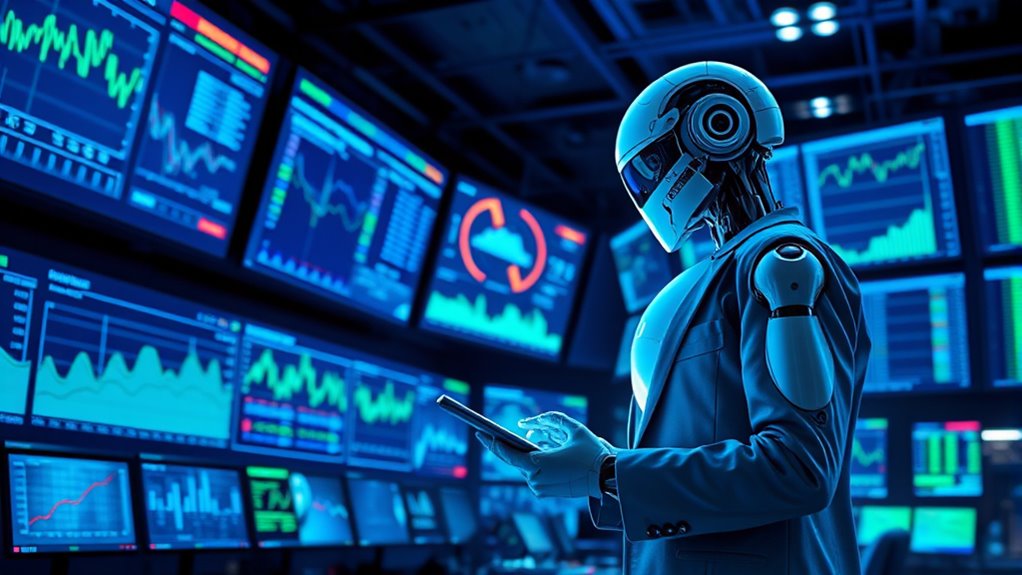The fear of widespread job losses from AI automation is common, but the numbers tell a different story. Around 78,000 tech roles are expected to be cut between early 2024 and mid-2025, which is a small slice of overall employment shifts. Many jobs are evolving rather than disappearing, and automation impacts vary by industry. If you want to understand how these trends actually affect your future, there’s more to explore below.
Key Takeaways
- About 491 tech workers are losing jobs daily to AI, totaling nearly 78,000 layoffs from Jan 2024 to mid-2025, indicating significant but targeted impact.
- Industry-specific automation risks vary; retail faces up to 65% automation by 2025, but overall employment shifts are gradual and often augment roles.
- Over 90% of US companies have integrated AI, with many replacing entire tasks or roles, yet automation often transforms rather than entirely eliminates jobs.
- Estimates suggest up to 85 million jobs could be replaced globally by 2025, but automation also creates new roles, balancing some displacement concerns.
- Worker perceptions often exaggerate displacement scope; data shows automation more frequently reshapes jobs than causes total extinction, emphasizing adaptation.

As AI automation accelerates across industries, concerns about widespread job losses dominate public discourse. You might feel overwhelmed by headlines warning of millions of jobs vanishing in the near future, but the data paints a more nuanced picture. Currently, about 491 tech workers lose their jobs daily to AI, and from January to mid-2025, nearly 78,000 tech roles have been cut directly because of automation. In the US alone, 13.7% of workers report personal experience of losing a job to robots or AI, with large tech firms like Microsoft, IBM, Meta, and Amazon leading the wave of layoffs. While these figures seem alarming, it’s essential to understand the broader context.
Automation impacts thousands of tech jobs daily, but understanding the broader context reveals a complex transformative landscape.
Industries are experiencing automation at different rates, with retail facing up to a 65% automation risk by 2025. Manufacturing has already seen the loss of 1.7 million jobs since 2000, mainly due to automation technologies. Even within the tech sector, roles like software engineering and human resources are seeing automation that redefines job responsibilities. Entry-level service roles are shrinking as routine tasks get replaced, and many companies are shifting business operations to cost-efficient regions like India, further impacting white-collar positions. These changes aren’t isolated; they’re transforming entire industries by redefining roles rather than eliminating all jobs outright.
Employer adoption of AI is widespread—by early 2025, 90% of US companies had integrated some form of AI, with over a third already replacing workers. Notably, about 40% of these companies automate entire tasks rather than just augment human efforts. Automation is shifting from supporting workers to replacing them completely, with companies expecting this trend to reshape the labor market profoundly. The World Economic Forum estimates around 85 million jobs could be replaced by AI by 2025, and PwC projects up to 30% of global jobs could be automatable by the mid-2030s. In the US, roughly 30% of jobs might be fully automated by 2030, with many more experiencing significant changes.
This shift has social and economic consequences. Entry-level opportunities are shrinking, and wages are under pressure as AI lowers employer costs. The disparity in job availability is growing, fueling concerns about social mobility and equality. Younger workers especially feel that traditional education may no longer guarantee job security, and increased offshoring coupled with AI adoption boosts global competition for jobs at all skill levels. Significantly, workers who’ve lost jobs to AI tend to overestimate the scope of displacement, suggesting that perceptions of automation’s threat often outpace reality. While automation will reshape the job landscape, the data indicates it’s more about transformation than extinction—an evolution that demands adaptation rather than panic. Additionally, understanding industry-specific automation trends can help workers better navigate this changing environment.
Frequently Asked Questions
How Can Businesses Balance Automation With Job Security?
You can balance automation with job security by investing in employee upskilling and clear communication. Focus on automation that augments roles rather than replaces them, especially for routine tasks. Involve workers in planning, promote continuous learning, and highlight automation as a tool for growth. Support shifts with policies like retraining programs and safety nets, creating a workforce that’s adaptable, motivated, and confident in their future within your evolving company.
What Are the Long-Term Impacts of Automation on Employment Trends?
You should recognize that automation will reshape employment trends over the long term. It will displace millions of jobs but also create new opportunities, especially with upskilling. As industries adapt, expect shifts in workforce demands and increased importance of AI-related skills. While some sectors face job reductions, others will expand, making continuous learning essential for staying relevant. Overall, automation will drive a dynamic, evolving job market.
How Reliable Are Data Sources Used to Assess Automation Effects?
When it comes to evaluating automation effects, you shouldn’t take data sources at face value. Their reliability varies depending on accuracy, completeness, and governance. Poor data quality can lead you astray, making you believe in a false picture. To truly understand automation’s impact, you need trustworthy, validated data—otherwise, you’re flying blind and risking misinformed decisions that could backfire down the line.
What Industries Are Most Vulnerable to Automation-Related Disruptions?
You’re wondering which industries face the greatest automation risks. Manufacturing tops the list, with robots replacing repetitive tasks and causing job losses. Retail and administrative sectors are also vulnerable, especially in customer service and clerical roles. The financial sector is increasingly automated in trading and banking. Recognizing these risks helps you prepare by upskilling in high-demand, tech-savvy roles, ensuring you stay relevant amid ongoing industry shifts.
How Do Cultural Differences Influence Automation Adoption and Perception?
Cultural currents critically shape how you perceive and pursue automation. If you overlook local customs, trust issues, or communication styles, adoption stalls, and skepticism soars. Embracing cultural cues—like politeness, hierarchy, or collective teamwork—boosts trust and increases acceptance. When organizations align automation strategies with regional norms, you’ll find smoother shifts, better teamwork, and boosted productivity, proving that understanding cultural differences isn’t just respectful—it’s essential for successful automation adoption.
Conclusion
So, next time you hear about robots stealing your jobs, remember—it’s just easier to panic than to look at the real numbers. Data shows automation isn’t an apocalypse, but a tool for growth. Yet, we’d rather cling to fears than face facts, because who needs progress when you can have a good old-fashioned panic? Embrace the numbers, or keep hiding behind the illusion—your choice, but the truth isn’t going away.








